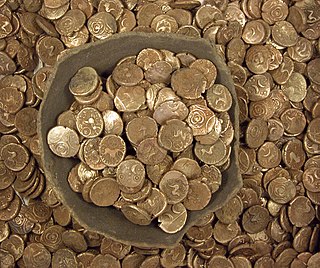 W
WThe Temple of Artemis or Artemision, also known less precisely as the Temple of Diana, was a Greek temple dedicated to an ancient, local form of the goddess Artemis. It was located in Ephesus. It was completely rebuilt twice, once after a devastating flood and three hundred years later after an act of arson, and in its final form was one of the Seven Wonders of the Ancient World. By 401 AD it had been ruined or destroyed. Only foundations and fragments of the last temple remain at the site.
 W
WThe Cisjordan corpus of Phoenician Iron Age hacksilber (hacksilver), dated between 1200 and 586 BC, is the largest identified collection of pre-coinage silver in the ancient Near East. The corpus was identified by Christine Marie Thompson in 2003. The corpus is composed of 34 silver hoards found at 15 sites in ancient southern Phoenicia or modern Israel and occupied territories, this area is termed "Cisjordan". Significant hoards have been found at Tel Dor, Eshtemoa, Tell Keisan, Ein Hofez, and Akko. The other hoards were found at Megiddo, Bet Shean, Shechem, Shiloh, Gezer, Tel Miqne-Ekron, Ashkelon, Ajjul, Ein Gedi, and Arad.
 W
WThe Hallaton Treasure, the largest hoard of British Iron Age coins, was discovered in 2000 near Hallaton in southeast Leicestershire, England, by volunteers from the Hallaton Fieldwork Group. The initial find was made by Ken Wallace on 19 November 2000, when he found about 130 coins with a metal detector.
 W
WThe Havor hoard is an Iron Age treasure found in 1961, in Hablingbo on the Swedish island of Gotland. It consists of a large gold torc, known as the Havor Ring, along with several well-preserved bronze objects and was buried inside a Roman bronze situla in the mound surrounding a hillfort.
 W
WThere are two notable Ipswich Hoards. The first was a hoard of Anglo-Saxon coins discovered in 1863. The second was a hoard of six Iron Age gold torcs that was discovered in 1968 and 1969. The latter hoard has been described as second only to the Snettisham Hoard in importance as a hoard from the Iron Age, and is held at the British Museum.
 W
WThe Leekfrith torcs are four Iron Age gold torcs found by two hobby metal detectorists in December 2016 in a field in Leekfrith, north Staffordshire, England. The find consists of three neck torcs and a smaller bracelet, which were located in proximity to each other. They are believed to be the oldest Iron Age gold jewellery found in Britain. Subsequent archaeological examination of the area did not uncover further objects.
 W
WThe Newark Torc is a complete Iron Age gold alloy torc found by a metal detectorist on the outskirts of Newark-on-Trent, Nottinghamshire, England, in February 2005.
 W
WThe Sedgeford Torc is a broken Iron Age gold torc found near the village of Sedgeford in Norfolk. The main part of the torc was found during harrowing of a field in 1965, and the missing terminal was found by Dr. Steve Hammond during fieldwork by the Sedgeford Historical and Archaeological Research Project in 2004. The torc is now displayed at the British Museum.
 W
WThe Snettisham Hoard or Snettisham Treasure is a series of discoveries of Iron Age precious metal, found in the Snettisham area of the English county of Norfolk between 1948 and 1973.
 W
WThe Vettersfelde Treasure or Witaszkowo Treasure is a treasure trove, which was found by chance in what was then Vettersfelde in the Province of Brandenburg in 1882, and is now in the Antikensammlung Berlin. The objects in the trove are connected to the animal-themed art of the Scythians. The origin of the trove remains mysterious.
 W
WThe Walkington Hoard is a hoard of Corieltavian gold staters. They are a widely-scattered hoard which have been found by metal-detectorists over the course of a decade.
 W
WThe Wickham Market Hoard is a hoard of 840 Iron Age gold staters found in a field at Dallinghoo near Wickham Market, Suffolk, England in March 2008 by car mechanic, Michael Dark using a metal detector. After excavation of the site, a total of 825 coins were found, and by the time the hoard was declared treasure trove, 840 coins had been discovered. The coins date from 40 BC to 15 AD.
 W
WThe Winchester Hoard is a hoard of Iron Age gold found in a field in the Winchester area of Hampshire, England, in 2000, by a retired florist and amateur metal detectorist, Kevan Halls. It was declared treasure and valued at £350,000—the highest reward granted under the Treasure Act 1996 at that time.